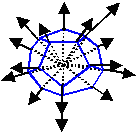
 Properties of Energy & Matter
Properties of Energy & Matterby James Clifford Cranwell 2/17/98
The Importance
of Ö26
of Ö26

 Properties of Energy & Matter
Properties of Energy & MatterThe value of the Gravitational constant is 6.67259 E-11 m^3 kg^-1 s^-2 This is almost exactly 1/(50c), one divided by (50 speed of lights) 50 is the smallest number Sum of two squares two ways. 50 = 7^2+1^2 = 5^2+5^2 (it's geometrically synchronous) Using 6.67259 E-11 the exact value is 1/(49.99019798881c) This (49.99019798881) can be manipulated into 325 2((49.99019798881+1)/4)^2 approx. = 325 (325.00003636728) 325 is the smallest number Sum of two squares three ways 325 = 1^2+18^2 = 6^2+17^2 = 10^2+15^2 Use 325, Reverse manipulation process, Reduce, 4Ö(325/2)-1 = 49.990195135928 = 10Ö26-1 G = 1/(10Ö26-1)c = 6.6725903807971 E-11 m^3 kg^-1 s^-2 Exactor In this instance the speed of light is just an amount of meters or a specific length , not meters/second. Anyone worried about units can use this as a value instead... Gravitational constant times the speed of light = Gc = 1/(10Ö26-1)G = 1/(10 Ö26-1)c
Ö26 has the unique property of being the square root of a perfect square plus one,
Ö((N^2)+1)
Any number in this form has a perfectly repeating continued fractional form
For N = 5
Ö26 = Ö((N^2)+1) = [ N,2N,2N,2N,2N,2N,2N,...2N ]
For N = 10
Ö26 = Ö((N/2)^2)+1) = [ N/2,N,N,N,N,N,N,...N ]
which gives us the very intriguing...
(10Ö26-1)c = (10 [5,10,10,10,10,10,10,...10 ]-1)c
that fits in really nice in our ten dimensional Universe.
In the Universal Gravitational Constant
i.e. G = 1/(10(Ö26)-1)c = 6.6725903807971 E-11
we have c (the speed of light ) times ten axis and also c ( the speed of light ) times negative one. Since the speed of light is a negative charge that makes two negatives or a positive force...Gravity.
Constants
 exit
exit